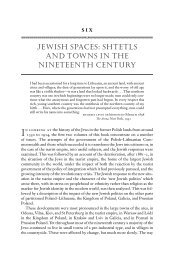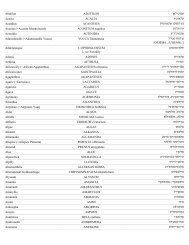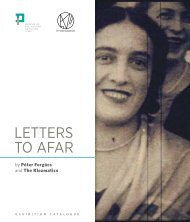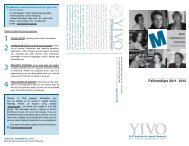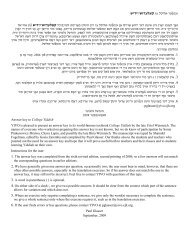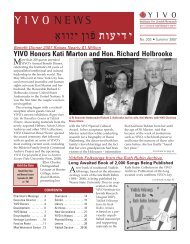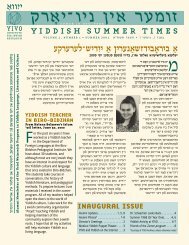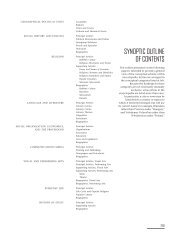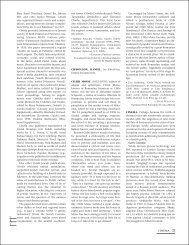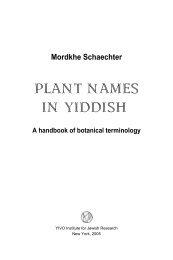geographical–political units - YIVO Institute for Jewish Research
geographical–political units - YIVO Institute for Jewish Research
geographical–political units - YIVO Institute for Jewish Research
Create successful ePaper yourself
Turn your PDF publications into a flip-book with our unique Google optimized e-Paper software.
Hersh Rasseyner. Hersh contends that in light of the<br />
destruction of European Jewry the question should<br />
not be how people of faith can continue to believe<br />
in God but rather how secularists can continue to<br />
believe in human beings. His attacks are countered<br />
by Khayim’s criticism of the Musar movement’s<br />
demand that its adherents withdraw from the world,<br />
and its contention that independent of the Torah all<br />
human beings will eventually be led down a path of<br />
degeneracy. The monumental, two-volume novel<br />
Tsemakh Atlas (1967–1968; translated as The Yeshiva) is<br />
Grade’s richest work about the Musar world and its<br />
attempt to shape the ethical personality. Through the<br />
memorable character of Tsemakh Atlas, a tortured<br />
teacher of Musar who is trapped between its selfabnegating<br />
demands, the enticements of the secular<br />
world, and his own elemental desires, readers enter<br />
a universe of high religious ideals, intellectual and<br />
moral debate, and intense spiritual struggle.<br />
Chaim Grade, New York, 1950 (<strong>YIVO</strong>)<br />
The memoir Der mames shabosim (1955; translated<br />
as My Mother’s Sabbath Days) uses personal experience<br />
as the basis <strong>for</strong> collective history and memorialization. Its three sections include vivid<br />
details about the material and political life of Vilna Jewry in the late 1930s as filtered<br />
through the life of his mother, the story of Grade’s own experiences as a war refugee in<br />
the Soviet Union, and a haunting description of his return to a landscape of destruction<br />
after the war. Though Grade’s other prose works also explore the traditional world<br />
of Lithuanian Jewry, they are more focused on capturing the day-to-day experience<br />
of ordinary Jews. The three novellas of Der shulhoyf (The Synagogue Courtyard; 1958)<br />
contrast the dire material condition of Vilna’s working poor against the beauty of their<br />
simple piety. Di agune (1961; translated as The Agunah) and the stories of Di kloyz un di<br />
gas (The Study House and the Street; 1974; translated as Rabbis and Wives, a finalist <strong>for</strong><br />
the Pulitzer Prize) and Der shtumer minyen (The Mute Prayer Quorum; 1976) explore<br />
the coexistence of the sacred and the profane in everyday prewar <strong>Jewish</strong> life. Through<br />
depictions of religious scholars caught up in their own vanities and ambitions, folk<br />
superstition, earthy, practical women, eager merchants, and fiery revolutionaries, Grade<br />
emerged as the most important prose elegist of Vilna Jewry, one who reveled in mining<br />
its social complexities. At the time of his sudden death in 1982 he was at work on an<br />
unfinished novel about his hometown on the precipice of its destruction.<br />
—Justin Daniel Cammy<br />
BIBLIOGRAPHY<br />
Edward Alexander, “A Dialogue of the Mind with Itself: Chaim Grade’s Quarrel with Hersh<br />
Rasseyner,” Judaism 21 (1972): 392–404.<br />
Hyman Bass (Chaim Bez), Oyf di vegn fun der yidisher literatur (Tel Aviv, 1980).<br />
Milton Konvitz, “Chaim Grade’s Quarrel,” Midstream 41.8 (1995): 19–23.<br />
Yudl Mark, “Khayim Grades Tsemakh Atlas,” Di goldene keyt 60 (1967): 248–255.<br />
Nakhmen Mayzel, “Khayim Grade,” in Forgeyer un mittsaytler, pp. 408–423 (New York, 1946).<br />
Moshe Moskowitz, “Chaim Grade and the <strong>Jewish</strong> Ego,” Judaism 25 (1976): 331–340.<br />
3



